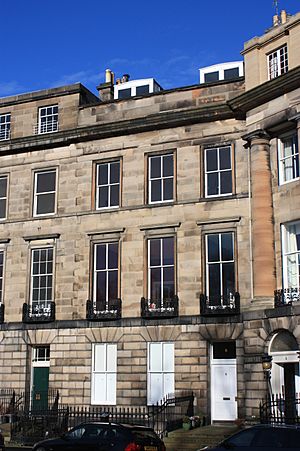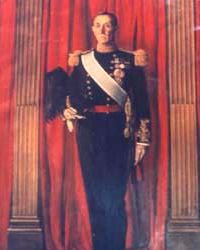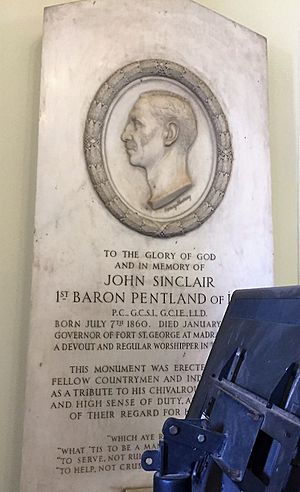John Sinclair, 1st Baron Pentland facts for kids
Quick facts for kids
The Lord Pentland
|
|
|---|---|
 |
|
| Governor of Madras | |
| In office 30 October 1912 – 29 March 1919 |
|
| Governor-General | The Lord Hardinge of Penshurst The Viscount Chelmsford |
| Preceded by | Sir Murray Hammick (acting) |
| Succeeded by | Sir Alexander Gordon Cardew (acting) |
| Secretary for Scotland | |
| In office 10 December 1905 – 13 February 1912 |
|
| Preceded by | The Marquess of Linlithgow |
| Succeeded by | Thomas McKinnon Wood |
| Member of Parliament for Forfarshire |
|
| In office 1897–1909 |
|
| Monarch | Victoria of the United Kingdom, Edward VII of the United Kingdom |
| Preceded by | Martin White |
| Succeeded by | James Falconer |
| Member of Parliament for Dunbartonshire |
|
| In office 1892–1895 |
|
| Monarch | Victoria of the United Kingdom |
| Preceded by | Sir Archibald Orr-Ewing, 1st Baronet |
| Succeeded by | Alexander Wylie |
| Personal details | |
| Born | 7 July 1860 |
| Died | 11 January 1925 (aged 64) United Kingdom |
| Nationality | British |
| Political party | Liberal Party |
| Spouse | Marjorie Adeline Gordon |
John Sinclair, 1st Baron Pentland (born July 7, 1860 – died January 11, 1925) was an important Scottish Liberal politician. He was also a soldier and a government official. He held two very important jobs: he was the Secretary for Scotland from 1905 to 1912, and then the Governor of Madras in India from 1912 to 1919.
John Sinclair was born into a well-known family. He became a Member of Parliament (MP) in 1892, which means he was elected to represent people in the British Parliament. He served in Parliament for several years. He also worked as a special assistant and secretary to Lord Aberdeen, another important figure.
During his time as Governor of Madras, John Sinclair became well-liked in India. He showed a lot of interest in Indian traditions and culture. However, he is also remembered for taking strong action against leaders of the Home Rule Movement, who wanted India to govern itself.
Sinclair was known as a "radical Liberal." This means he strongly supported new ideas to help people and make society fairer. He believed the government should step in to help those who were struggling. He also worked hard to create laws that were specifically good for Scotland. For example, he supported a law in 1908 that improved teacher training, school buildings, and even provided meals for students. He also helped Scottish farmers get better land rights.
Contents
Early Life and Family Background
John Sinclair was born in Edinburgh, Scotland, on July 7, 1860. His birthplace was 6 Moray Place. His father was Captain John Sinclair, an officer in the British army in India. His mother was Agnes Sinclair. John was the oldest of three sons.
His family had a long history. His grandfather was Sir John Sinclair, a baronet from Dunbeath. This means his family had a special title passed down through generations. He was also distantly related to the Earls of Caithness.
Education and Military Service
John Sinclair went to school at Edinburgh Academy and Wellington College. After finishing school in 1878, he joined the Royal Military College, Sandhurst. This is a famous military school. He graduated in 1879 and became an officer in the 5th Royal Irish Lancers, a cavalry regiment.
He served as a captain in the Sudan expedition, a military campaign, and returned in 1887.
Starting His Political Journey
John Sinclair was interested in politics from a young age. He joined a group at Toynbee Hall in London. There, he worked to help poor people by promoting education and sports. He even helped start the London Playing Fields Society, which created sports areas for those who couldn't afford them.
In the 1880s, Sinclair joined the Liberal Party. He tried to get elected to Parliament from Ayr Burghs in Scotland. He supported "Home Rule for Ireland," which meant Ireland would have more control over its own government. However, he did not win that election.
Later, he worked as a special assistant to Lord Aberdeen. He helped Lord Aberdeen when he was in charge of Ireland in 1886. He also went with Lord Aberdeen to Canada, where Lord Aberdeen was the Governor-General, a top government official.
In 1889, John Sinclair was elected to the first London County Council. This was a local government body for London. He served for three years, representing Finsbury East.
Serving in the British Parliament
In 1892, John Sinclair was elected as a Liberal MP for Dunbartonshire. He held this seat until 1895. He was elected again in 1897 for Forfarshire and served until 1909.
For many years, he worked closely with Sir Henry Campbell-Bannerman, who later became Prime Minister.
On December 11, 1905, he became a Privy Councillor. This is a special group of advisors to the King or Queen. Then, on February 15, 1909, he was given the title of Baron Pentland. This made him a member of the House of Lords.
Marriage and Family Life
On July 12, 1904, John Sinclair married Lady Marjorie Adeline Gordon. She was the daughter of the 1st Marquess of Aberdeen and Temair, who was his former boss.
They had two children:
- Henry John Sinclair, 2nd Baron Pentland (born 1907, died 1984). He became the 2nd Baron Pentland after his father passed away. He was also known for his work with The Gurdjieff Foundation in New York. He had one daughter.
- Hon. Margaret Ishbel Sinclair (born 1906).
As Secretary for Scotland
Lord Pentland served as the Secretary for Scotland from 1905 to 1912. This role meant he was responsible for many government matters in Scotland.
During his time, important changes happened. For example, women were allowed to vote and be elected to local councils. Lavinia Malcolm became the first lady provost (like a mayor) and town councilor in Scotland, in Dollar, Clackmannanshire. Many ideas were proposed to give Scotland more control over its own affairs, but these ideas did not become law.
Pentland tried to pass a law called the Taxation of Land Values (Scotland) Bill. This bill aimed to create a new Board of Agriculture for Scotland to help with land distribution. The House of Commons approved it, but the House of Lords, another part of Parliament, rejected it. Another bill he proposed was also rejected.
Pentland was well-liked by the Prime Minister, Campbell-Bannerman. Pentland's Agriculture Act made the Secretary of Scotland responsible to Parliament for farming issues. In 1907, he told Scottish MPs that the government was aware of Scotland's problems.
He was Secretary of State for Scotland during the Oscar Slater case in 1909. This was a famous case where a man was wrongly accused. Pentland changed Slater's death sentence to life in prison. However, he did not fully investigate concerns that the police and other officials might have made mistakes. Slater's conviction was later overturned in 1928.
In February 1912, Pentland stepped down as Secretary for Scotland. Thomas McKinnon Wood took over his role.
As Governor of Madras
Lord Pentland served as the Governor of Madras in India from 1912 to 1919. For most of this time, British India was involved in the First World War.
Building the Pamban Bridge
In 1911, before Pentland arrived, a railway bridge was planned to connect Pamban Island to the Indian mainland. This bridge would help trade and tourism. It would also make it easier for people to visit the holy Hindu temple at Rameswaram.
The bridge was 2.06 kilometers (about 1.28 miles) long. It was built by a German engineer named Scherzer. It took two years to build and cost about 2 million rupees. Amazingly, no workers lost their lives during its construction. Lord Pentland officially opened the bridge on February 24, 1914. The Pamban bridge is India's largest sea bridge and is now a UNESCO World Heritage monument.
Pentland and Patrick Geddes
In 1914, Pentland invited Patrick Geddes, a Scottish botanist and architect, to hold an exhibition in Madras. This exhibition was about town-planning, which means designing cities and towns. Geddes arrived in Madras on December 20, 1914. Pentland had been interested in Geddes's ideas since 1890.
Geddes had prepared many illustrations and maps for his exhibition. However, the ship carrying them, the "Clan Grant," was sunk by a German ship called the Emden. This delayed Geddes's visit by a few months. He had to recreate all his presentations.
The Cities and Town Planning Exhibition opened on January 17, 1915, at the Madras University. Governor Pentland opened the exhibition and gave a speech. Patrick Geddes then gave a detailed talk about how to plan towns and improve sanitation in a cost-effective way. He used real examples and showed many illustrations.
Geddes spent months in Madras, exploring the area and writing reports about different towns. He convinced Pentland to hire a town planning advisor. In October 1915, H. V. Lancaster joined the Madras government for this role.
During the First World War
During the war, Pentland helped set up a hospital ship. This ship traveled between Africa, India, and the Middle East. It cared for injured sailors. Wealthy citizens of Madras paid for and maintained this hospital ship.
In 1914, a government department for industries was restarted. This department helped the province quickly develop factories. These factories made things like soap, ink, paper, and military equipment for the British army. This was important to support the war effort.
On September 22, 1914, a German warship called the Emden attacked Madras. It shelled the oil tanks of the Burmah Oil Company on the shore. Two tanks caught fire, and a lot of oil was lost. Three people were killed, and an Indian ship was damaged. The attack lasted only fifteen minutes before the Emden sailed away.
Even though not many people were hurt, the attack caused a lot of damage. The people of Madras were very scared. The SMS Emden became a famous part of local stories.
In 1915, the Home Rule Movement began. This movement wanted India to have more control over its own government. In Madras, it was led by Annie Besant and Sir S. Subramania Iyer. As the movement grew, Pentland responded by arresting Annie Besant in June 1917. Other leaders were also arrested. These arrests were strongly criticized by many, including Mohammad Ali Jinnah.
Pentland and Rameswaram Temple
Lord and Lady Pentland were very interested in Hindu religion and philosophy. Pentland was fascinated by the Hindu temple at Rameswaram. He visited it when the Pamban Bridge opened. He even suggested that the Viceroy (the highest British official in India) should create a committee to explore the area under the sea near the temple.
Pentland's Approach to Governance
Pentland was a British politician who believed in trying to keep Indians happy with words, rather than always with big actions. The industrial development he supported was mainly to help the economy during the First World War.
Lord Pentland is also remembered for helping the famous Indian mathematician Srinivasa Ramanujan travel to England.
Pentland once commented on the poverty of people in Madras city. He suggested that going to cinema halls often might be a reason for their poverty. This shows that many people were going to the movies during his time as Governor.
Later Life and Passing
John Sinclair passed away in 1925. His son, Henry John Sinclair, then became the 2nd Baron Pentland.
He is buried in Dean Cemetery in Edinburgh. His grave is simple and located in the north-west part of the cemetery.
Awards and Recognition
Pentland received several important honors. He was made a Knight Grand Commander of the Order of the Indian Empire in 1912. In 1918, he became a Knight Grand Commander of the Order of the Star of India. These were high honors given by the British Crown for service in India.
|





